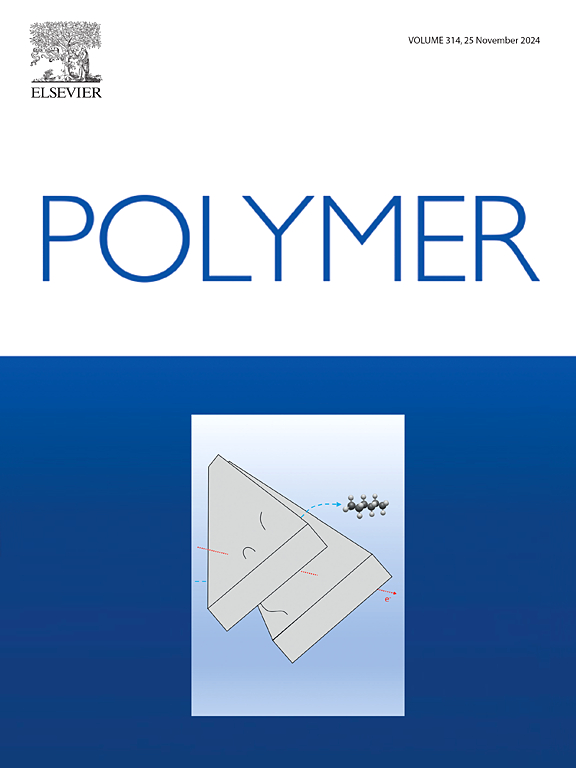Functionalized polyimide reactive macromer enhanced alkali-soluble photosensitive polymer for solder resist material
IF 4.1
2区 化学
Q2 POLYMER SCIENCE
引用次数: 0
Abstract
Polyimide (PI) exhibits excellent comprehensive properties due to its unique molecular structure. In this study, PI reactive macromer was introduced as an additive into alkali-soluble photocurable epoxy resin (EP) to serve as the matrix resin for solder resist (SR), and the enhancing effects of PI reactive macromer on the performance of solder resist materials were systematically evaluated. By capitalizing on the superior properties of PI and its ideal chemical compatibility with EP, SR achieved significant improvements in high flexibility, high heat resistance, and other properties. The results indicate that the addition of PI reactive macromer exhibited remarkable thermodynamic enhancement effects. SR-2 with 20 wt% PI addition demonstrated a tensile strength of 89.6 MPa, an elongation at break of 5.8 %, and a glass transition temperature of 177.1 °C. Additionally, SR-2 exhibited low dielectric constant, low water absorption, high adhesion, good resolution, and excellent acid and alkali resistance. This study provides a scalable strategy for the design of SR matrix resins. Integrating the intrinsic benefits of PI reactive macromer with alkali-soluble photocurable resin, it lays the foundation for developing next-generation SR to meet the demands of modern electronic manufacturing.


功能化聚酰亚胺反应性高分子增强碱溶性光敏聚合物的阻焊材料
聚酰亚胺(PI)由于其独特的分子结构而表现出优异的综合性能。本研究将PI反应性大分子作为添加剂引入到碱溶性光固化环氧树脂(EP)中,作为阻焊剂(SR)的基体树脂,系统评价了PI反应性大分子对阻焊剂材料性能的增强作用。通过利用PI的优异性能及其与EP的理想化学相容性,SR在高柔韧性、高耐热性和其他性能方面取得了显着改善。结果表明,PI反应性大分子的加入表现出明显的热力学增强效应。添加20 wt% PI的SR-2的抗拉强度为89.6 MPa,断裂伸长率为5.8%,玻璃化转变温度为177.1℃。此外,SR-2具有低介电常数、低吸水性、高附着力、良好的分辨率和优异的耐酸碱性能。本研究为SR基树脂的设计提供了一种可扩展的策略。它结合了PI反应性高分子与碱溶性光固化树脂的固有优势,为开发满足现代电子制造需求的下一代SR奠定了基础。
本文章由计算机程序翻译,如有差异,请以英文原文为准。
求助全文
约1分钟内获得全文
求助全文
来源期刊

Polymer
化学-高分子科学
CiteScore
7.90
自引率
8.70%
发文量
959
审稿时长
32 days
期刊介绍:
Polymer is an interdisciplinary journal dedicated to publishing innovative and significant advances in Polymer Physics, Chemistry and Technology. We welcome submissions on polymer hybrids, nanocomposites, characterisation and self-assembly. Polymer also publishes work on the technological application of polymers in energy and optoelectronics.
The main scope is covered but not limited to the following core areas:
Polymer Materials
Nanocomposites and hybrid nanomaterials
Polymer blends, films, fibres, networks and porous materials
Physical Characterization
Characterisation, modelling and simulation* of molecular and materials properties in bulk, solution, and thin films
Polymer Engineering
Advanced multiscale processing methods
Polymer Synthesis, Modification and Self-assembly
Including designer polymer architectures, mechanisms and kinetics, and supramolecular polymerization
Technological Applications
Polymers for energy generation and storage
Polymer membranes for separation technology
Polymers for opto- and microelectronics.
 求助内容:
求助内容: 应助结果提醒方式:
应助结果提醒方式:


